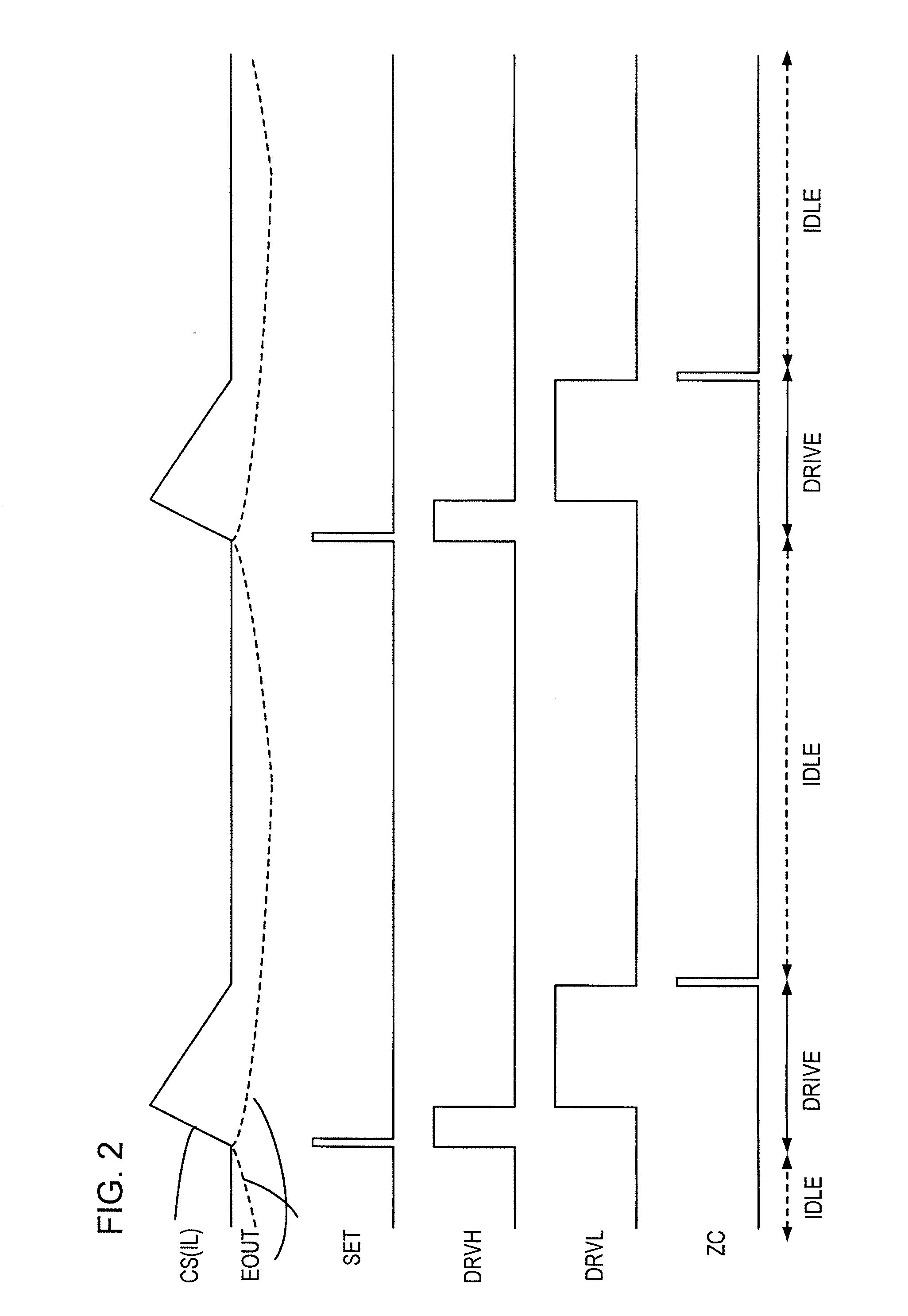Switching regulator
a switching regulator and regulator technology, applied in the direction of electric variable regulation, process and machine control, instruments, etc., can solve the problems of insufficient improvement of efficiency in the conventional switching regulator, loss of inductor hysteresis, loss of inductor current,
- Summary
- Abstract
- Description
- Claims
- Application Information
AI Technical Summary
Benefits of technology
Problems solved by technology
Method used
Image
Examples
first embodiment
[0042]FIG. 4 is the configuration diagram of a switching regulator according to a first embodiment. The switching regulator stop or suspends the operation of a current sense amplifier 12 and a one pulse generation circuit 16 which generates a pulse CP is suspended (or minimizes the bias currents), when a sleep signal SLP# (where # signifies that an active state is produced when the signal of concern is in the L level), which guarantees a small load current and no occurrence of a sudden change in the load current, is received from either a load circuit 2 to which a second supply voltage VOUT is supplied or a control unit which controls the load circuit 2 (both together are designated as a load system). Here, an error amplifier 10 and a current comparator 14 are maintained to be in operational states, and further, when detecting a decrease of the second supply voltage VOUT supplied to the load circuit 2, the current sense amplifier 12 and the one pulse generation circuit 16 whose oper...
second embodiment
[0061]FIG. 8 is the configuration diagram of a switching regulator according to a second embodiment. FIG. 9 is a timing chart illustrating the operation of the switching regulator depicted in FIG. 8. In FIG. 8, a point of difference in configuration from the first embodiment depicted in FIG. 4 is that there are provided an ON-time timer circuit having a flip-flop 161 and a timer circuit 162 as the one pulse generation circuit 16, and further, an overcurrent protection circuit 26 and an overvoltage & undervoltage protection circuit 28. Other configuration is identical to the configuration depicted in FIG. 4. Here, the LSI chip 1 in the switching regulator is omitted in FIG. 8.
[0062]In the one pulse generation circuit 16, the flip-flop 161 is set in response to the trigger signal SET or SET′, so as to set the output Q to the H level. After a constant time W from the rise edge of the output Q, the timer circuit 162 sets an output to the H level, and in response thereto, the flip-flop 1...
third embodiment
[0070]FIG. 10 is the configuration diagram of a switching regulator according to a third embodiment. In FIG. 10, the LSI chip 1 of the switching regulator is omitted. In FIG. 10, a point of difference in configuration from FIG. 4 is that the current comparator includes two current comparators 14-1, 14-2. A first current comparator 14-1 is a circuit capable of fast responding to an input variation, while a second current comparator 14-2 is a circuit with a slower response speed than the first current comparator 14-1.
[0071]FIG. 11 illustrates circuit diagrams of the current comparators 14-1, 14-2, respectively. The two circuits are of equivalent configuration, each including: PMOS transistors P1, P2 which compare the output voltage EOUT with CS; PMOS transistors P3, P4 connected as the loads of the PMOS transistors P1, P2; and an output PMOS transistor P5 whose gate is connected to the drain terminal of the PMOS transistor P2. Further, each current comparator includes: a bias current ...
PUM
 Login to View More
Login to View More Abstract
Description
Claims
Application Information
 Login to View More
Login to View More - R&D
- Intellectual Property
- Life Sciences
- Materials
- Tech Scout
- Unparalleled Data Quality
- Higher Quality Content
- 60% Fewer Hallucinations
Browse by: Latest US Patents, China's latest patents, Technical Efficacy Thesaurus, Application Domain, Technology Topic, Popular Technical Reports.
© 2025 PatSnap. All rights reserved.Legal|Privacy policy|Modern Slavery Act Transparency Statement|Sitemap|About US| Contact US: help@patsnap.com



